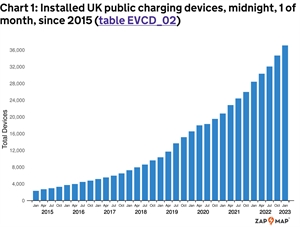Latest figures show public charging devices installed in UK increased 31% in 2022 - ultra-rapid up by 80%
Wed 25 January 2023
View all news

The latest Government figures on the number of public EV charging devices in the UK show an increase of 31% during 2022. However, a growing number of vehicles are able to charge at higher speeds with ultra-rapid (100kW+) devices appearing at the fastest rate.
Meanwhile, according to the latest Government figures, the UK plug-in vehicle parc grew by over 50% in the 12 months to Sept 2022.
While most current electric vehicle owners are able to charge their vehicles off-road at home (the large majority of chargers are privately owned) access to public, shared charging facilities is an increasing area of focus for drivers needing to travel long distances and for people without access to home charging.
According to Government statistics (based on data provided by Zap-Map), as of 1 January 2023, there were 37,055 public electric vehicle charging devices installed in the UK, of which:
- 2,295 were 'ultra-rapid' devices (100kW+, 6% of all charging devices)
- 4,592 were rated 'rapid' devices or above (25kW to 100kW, 13% of total)
- 21,255 were rated 'fast' chargers (7kW to 22KW, 57% of total)
'Ultra-rapid' charging devices have seen the fastest growth rate (10% in the last quarter alone) though from a lower base. 'Fast' chargers are still the most common category to be publicly installed, growing by 33% or 5,247 devices in 2022.
London has the highest number of public chargepoints per 100,000 people, reflecting the number of residents without access to off-street parking. Northern Ireland has significantly the lowest provision in the UK per capita whilst Wales saw the greatest percentage increase in 2022.
Over a third of public UK chargers are located on residential streets and the number of 'slow' (typically overnight) chargers increased by 24% in 2022 showing that the picture for on-street provision is improving.
According to the BBC, the latest available data suggests the number of vehicles that can use charging devices is growing at a faster rate than available chargepoints. In the year to September, the number of electric vehicles of all types in the UK rose to over 1m, up 54% compared with a year before.
Zemo's internal analysis, however, shows that public charging capacity (measured in kW) grew by about 43% in 2022, reflecting the move to higher power (and, therefore, faster) charging provision.
Zemo has consistently maintained that the main focus of policy should not be on the 'headline' total number of public chargers, but on having the right chargers in the right places and on making sure they are used and useable by all.
A new report from non-profit organisation New Automotive (which works to support and accelerate the UK’s transition to electric vehicles) says that the UK’s public infrastructure rollout is on track to meet Government objectives. The 'On the Road to 2030' report also highlights that EV drivers can still make significant running cost savings compared with fossil fuelled cars, even though public charging costs have risen sharply.
A key obstacle to chargepoint installation according to the report is the cost of upgrading local electricity connection to allow for higher usage. It notes, however, that Ofgem’s recent decision to reform charges for electricity grid connections should help remedy this.
Other challenges include regulatory changes and difficulty in securing planning permission to lay new electrical cabling across land. The report says that the Government’s Zero Emission Vehicle (ZEV) mandate will be important in terms of addressing these barriers and ensuring that the charging network grows at pace.
Ciara Cook of New Automotive said: “There have been a lot of concerns recently about the UK’s electric car charging infrastructure. This report represents the most comprehensive examination thus far carried out on the UK’s fledgling charging infrastructure industry. The findings are reassuring, especially given recent concerns around the rate of network growth.
“The network is not perfect - it is still a work in progress, and there are definitely still teething problems with both the existing infrastructure and the rollout of new infrastructure. However, the rollout is progressing at an adequate pace, growing by a third every 12 months, and the UK is on track to meet the government’s target of 300,000 public chargers by 2030.”
Meanwhile, the latest SMMT data shows that UK production of electric cars rose to nearly a third of all production in 2022. UK factories produced a record 234,066 battery electric (BEV), plug-in hybrid (PHEV) and hybrid (HEV) electric vehicles, with combined volumes up 4.5% year-on-year. Total BEV production rose 4.8%, with hybrid volumes up 4.3%.
The UK electrified vehicle production figures rose against a declining overall production. Just over 775,000 units were made in 2022, down nearly 10% from 2021 production of close to 860,000 vehicles.
Note: The Zemo Partnership-convened EV Energy Taskforce has been working with Government and stakeholders to establish a consensus on a 'no regrets' pathway to electrifying road transport. The aim of the Taskforce's study ('Charging the Future: Drivers for Success') was to identify the essential elements of a functioning ecosystem that will meet the requirements of EV users over the next ten years.
Related Links
< Back to news list